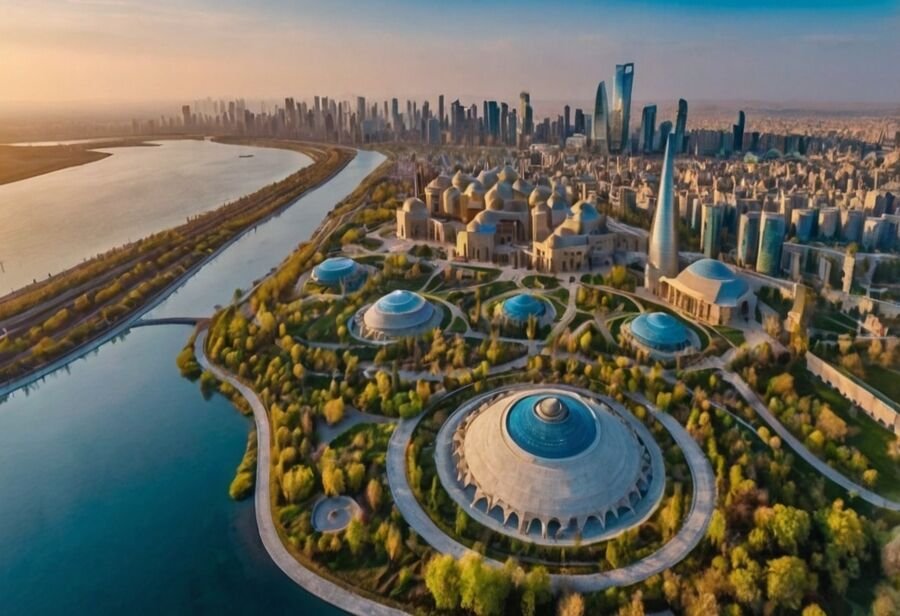Asia Travel Pulse
Sustainability Asia 2025: Pioneering Sustainable Tourism Practices in Asia

Saturday, August 2, 2025
The eagerly anticipated Sustainability Asia 2025 program, set to be held on October 14, 2025, in Singapore, will be a landmark event in shaping the future of sustainable tourism in Asia. This highly awaited gathering will bring together leaders from government bodies, international organizations, the private sector, and local communities to discuss strategies, innovations, and initiatives that aim to make tourism in Asia more environmentally friendly, socially responsible, and economically beneficial.
As one of the most diverse and rapidly growing tourism markets globally, Asia’s tourism sector is faced with significant challenges related to environmental sustainability, cultural preservation, and community impact. The Sustainability Asia 2025 program is a crucial opportunity for stakeholders across the region to collaborate, share ideas, and develop actionable solutions that ensure the future of tourism in Asia aligns with global sustainability goals.
Asia’s Growing Tourism and Sustainability Challenges
Asia has seen a massive influx of international visitors over the last few decades, with countries like Thailand, India, China, Japan, and Indonesia becoming top travel destinations. According to the United Nations World Tourism Organization, Asia-Pacific is one of the fastest-growing regions in terms of both inbound and outbound tourism. This rapid expansion has brought both opportunities and challenges.
While tourism is a key driver of economic growth in many Asian countries, it has also put immense pressure on local ecosystems, cultural heritage, and community well-being. Overcrowding in popular destinations, waste management issues, and the degradation of natural sites have become major concerns. Moreover, climate change has exacerbated these issues, further impacting the delicate balance between economic development and environmental preservation.
Given these challenges, there is a growing realization that tourism must evolve to become more sustainable. The Sustainability Asia 2025 program will serve as a platform to explore how the tourism sector can be part of the solution rather than the problem.
Key Objectives of the Sustainability Asia 2025 Program
The Sustainability Asia 2025 program will focus on several key objectives, each aimed at driving positive change in the tourism industry:
- Promoting Green Practices in Tourism
One of the core themes of the program will be promoting eco-friendly practices across the tourism value chain. From sustainable hotel operations to eco-tourism ventures and green transport options, the event will showcase best practices and innovative solutions that minimize the carbon footprint of tourism activities. A particular focus will be on renewable energy use, waste management, and water conservation in tourist destinations. - Building Partnerships for Responsible Tourism
Collaboration is essential for creating a more sustainable tourism model. The program will encourage partnerships between governments, businesses, and local communities. These partnerships will focus on ensuring that tourism benefits everyone, from local residents to visitors, by fostering a more inclusive and equitable tourism industry. - Preserving Cultural Heritage and Local Communities
In addition to environmental sustainability, the Sustainability Asia 2025 program will emphasize the importance of preserving cultural heritage. This includes promoting community-based tourism, where local people play an active role in managing and benefiting from tourism. Preserving cultural practices and traditions is vital in ensuring that tourism enhances rather than dilutes local cultures. - Leveraging Technology for Sustainability
Technology will play a pivotal role in the discussions at the event. From digital platforms that facilitate eco-friendly travel choices to innovations in sustainable infrastructure, the event will explore how technology can help the tourism industry become more sustainable. This includes exploring the potential of smart cities, data analytics for better resource management, and AI-driven solutions to minimize the environmental impact of travel. - Tourism as a Catalyst for Positive Change
Lastly, the program will focus on tourism’s role in promoting social responsibility. Beyond just economic gains, tourism has the potential to drive positive change in communities by fostering awareness about environmental issues and supporting local conservation efforts. The program will highlight initiatives where tourism has successfully supported environmental conservation, wildlife protection, and social initiatives.
Government and Industry Support: A Key to Sustainability
Governments in Asia are increasingly recognizing the importance of integrating sustainability into their tourism policies. Several countries, including Singapore, Thailand, and Japan, have already begun implementing policies that promote sustainable tourism. These include incentives for businesses to adopt green practices, restrictions on over-tourism in certain areas, and investment in conservation projects. The Sustainability Asia 2025 program will provide a forum for these governments to share their experiences and discuss the development of more comprehensive, region-wide policies.
For instance, Singapore’s Tourism Board has been at the forefront of promoting sustainable tourism through initiatives such as the Green Tourism Program, which encourages hotels and attractions to adopt eco-friendly practices. Thailand’s Ministry of Tourism and Sports is also heavily involved in promoting sustainable tourism, particularly through its “Sustainable Tourism Policy,” which aims to balance tourism growth with the preservation of the country’s natural and cultural resources.
The Sustainability Asia 2025 program will also feature private sector participation, with companies in the tourism and hospitality industries showcasing their efforts to operate sustainably. From airlines to hotel chains and tour operators, many businesses in the region are embracing sustainability as a core part of their operations. These companies will be on hand to share their initiatives, strategies, and insights into how they are reducing their environmental impact and enhancing the sustainability of their services.
The Impact on Tourism: A New Era for Responsible Travel
The Sustainability Asia 2025 program is poised to reshape tourism in the region by inspiring a new generation of responsible travelers. As sustainability becomes a growing priority for consumers, travelers are increasingly looking for destinations, experiences, and services that align with their values. The program will provide destinations with the tools and knowledge to attract this segment of conscious travelers, who are more likely to choose destinations that prioritize sustainability.
Destinations that embrace sustainable tourism will likely experience long-term benefits, including the preservation of their natural and cultural resources, improved quality of life for local communities, and enhanced resilience against the negative effects of over-tourism. Sustainable tourism can also create new job opportunities, particularly in rural and underserved areas, by promoting community-based tourism and local businesses.
For businesses in the tourism sector, adopting sustainable practices is no longer just a trend but a competitive necessity. Consumers are increasingly making travel decisions based on the environmental and social impact of their choices. As such, companies that adopt sustainable practices will gain a competitive edge, attracting not only environmentally conscious travelers but also investors who are increasingly looking to support businesses with responsible operations.
Conclusion: A Vision for the Future of Tourism in Asia
The Sustainability Asia 2025 program represents a pivotal moment for the tourism industry in Asia. As one of the most dynamic and diverse tourism regions in the world, Asia has the potential to lead the way in creating a sustainable future for travel. With the right mix of government policies, private sector innovation, and community engagement, the tourism industry can evolve into a powerful force for good—benefiting not only travelers but also the environment and local communities.
As the event approaches, all eyes will be on Singapore as a hub for the future of sustainable tourism in Asia. The discussions and partnerships forged at the Sustainability Asia 2025 program will undoubtedly influence the direction of tourism in the region for years to come, setting the stage for a greener, more responsible travel industry.
Asia Travel Pulse
Thailand Joins Vietnam, Malaysia and Singapore in Experiencing a Massive Surge in Chinese Tourists Arrivals, Everything You Need to Know Now

Sunday, August 3, 2025
Southeast Asia has become a prime destination for Chinese tourists, as the region witnesses a remarkable surge in Chinese tourists. The growth in Chinese tourism is reshaping the tourism landscape, with countries like Thailand, Vietnam, Malaysia and Singapore benefiting from this influx. Government-verified sources confirm these trends, highlighting a series of developments that are driving this growth. Here’s a detailed report on the surge in Chinese tourists in these countries and what it means for the region’s economic and cultural landscape.
Thailand – Leading the Surge in Chinese Tourists
Thailand has long been a favorite destination for Chinese tourists. In 2024, the country welcomed 6.7 million Chinese tourists, marking a 91.7% increase from the previous year. This surge was driven by the introduction of a visa-free policy for Chinese nationals, which significantly boosted travel from China.
By July 2025, Thailand had already recorded 2.64 million Chinese visitors, with China becoming the top source market for tourism. Although the country faced a 24% year-on-year drop in Chinese arrivals during the first quarter of 2025, the overall trend remains positive. The Thai government has focused heavily on tourism campaigns and the introduction of favorable visa policies has helped solidify Thailand’s position as the leading destination for Chinese tourists in Southeast Asia.
Vietnam – A Growing Competitor of the Surge in Chinese Tourists
Vietnam has emerged as a strong contender in the Southeast Asian tourism market. In 2024, the country welcomed 3.7 million Chinese tourists, reflecting a significant rise from previous years. In the first quarter of 2025, Vietnam surpassed Thailand with 1.6 million Chinese visitors, compared to Thailand’s 1.3 million. This surge has been attributed to the growing connectivity between Vietnam and China, alongside aggressive promotional campaigns aimed at Chinese tourists.
Malaysia – A Hub for Chinese Tourists
Malaysia has also seen a notable rise in Chinese tourist arrivals. In 2024, 3.29 million Chinese visitors flocked to the country, contributing to a total of over 25 million international arrivals. Malaysia’s tourism sector continues to thrive, with the country aiming to attract 31.3 million international visitors in 2025, a significant portion of which is expected to come from China.
One of the key factors driving the growth in Chinese arrivals is Malaysia’s introduction of visa-free entry for Chinese travelers in December 2023. This policy has made it easier for Chinese tourists to explore the country’s diverse cultural and natural attractions. The government’s focus on boosting Malaysia’s tourism industry, along with the country’s rich offerings in shopping, history and natural beauty, makes it a top destination for Chinese visitors.
Singapore – Attracting Record Numbers of Chinese Tourists
Singapore has seen a surge in Chinese tourism, with 2.89 million visitors from China in 2024, a 134.1% increase year-on-year. In 2025, the growth continued, with the city-state recording 1.37 million Chinese visitors in May alone. This increase is driven by Singapore’s modern infrastructure, luxury shopping opportunities and vibrant cultural experiences.
The Singapore Tourism Board (STB) has focused on drawing Chinese tourists through a combination of promotional campaigns and strategic partnerships. With its strong ties to China, the country remains a popular choice for Chinese travelers, particularly during peak travel periods.
Conclusion – The Economic Impact of the Surge in Chinese Tourists
The surge in Chinese tourist arrivals across Southeast Asia is having a significant impact on the region’s economy. The tourism sector, which plays a vital role in the GDP of these countries, is benefiting from the growing number of Chinese visitors. These travelers are contributing to job creation in hospitality, retail, and transportation, making tourism a critical driver of economic growth.
As the region continues to experience a surge in Chinese arrivals, the need for enhanced infrastructure, improved connectivity and strategic marketing efforts will be crucial to sustaining this growth. Governments in Thailand, Vietnam, Malaysia and Singapore are clearly aware of the importance of Chinese tourism and their policies reflect a commitment to making Southeast Asia an even more attractive destination for travelers from China.
Asia Travel Pulse
Azerbaijan Unlocks Central Asia Tourism Potential, Attracting Record Numbers from Kazakhstan and Uzbekistan with Strategic Initiatives and Seamless Connectivity : New Update You Need to Know

Sunday, August 3, 2025
Azerbaijan is successfully unlocking the tourism potential of Central Asia, particularly attracting record numbers of visitors from Kazakhstan and Uzbekistan. This surge in tourism can be attributed to a series of strategic initiatives, including visa-free travel for citizens of both countries and the expansion of direct flight routes to Baku. These efforts have made Azerbaijan more accessible and appealing to Central Asian travelers. Additionally, Azerbaijan’s rich cultural heritage, stunning landscapes, and vibrant cities, combined with targeted promotional campaigns and events like Dream Fest, are drawing increasing attention from the region, solidifying its position as a top travel destination.
Azerbaijan is making significant efforts to boost its tourism sector by targeting visitors from Central Asia, with a particular emphasis on attracting travelers from Kazakhstan and Uzbekistan. With growing interest in Azerbaijan’s rich cultural heritage, beautiful landscapes, and vibrant cities, the country is making efforts to tap into the potential of these neighboring regions.
To promote these efforts, the Azerbaijan Tourism Board recently organized a familiarization trip for tourism representatives from Kazakhstan and Uzbekistan. The objective was to showcase the wide array of tourism experiences available throughout Azerbaijan.The tour included visits to Baku, the nation’s lively capital, as well as scenic spots such as Shamakhi and Basqal, known for their picturesque landscapes and historic significance. The participants also explored the Caspian Sea coastline, visiting popular beach resorts and hotels that offer a relaxing getaway.
A standout event during the trip was the Dream Fest, a renowned annual music festival hosted at the Sea Breeze Resort. This event has become a favorite among regional travelers, offering a blend of entertainment, cultural performances, and an idyllic beachside setting. Dream Fest has grown in popularity, attracting a large crowd and contributing to the country’s status as a key cultural destination for tourists seeking both relaxation and unique experiences.
The familiarization tour also included a business-to-business networking session, where nearly 60 Azerbaijani destination management companies and hotels participated. This session was designed to strengthen tourism partnerships between Azerbaijan and Central Asia, laying the foundation for long-term collaboration and tourism development. These meetings provided a valuable opportunity for stakeholders to discuss future projects and initiatives aimed at expanding tourism between the regions.
Azerbaijan has begun to witness encouraging outcomes from its initiatives aimed at drawing more tourists from Central Asia. According to the Azerbaijan Tourism Board, over 68,000 visitors from Kazakhstan and Uzbekistan traveled to Azerbaijan during the first half of this year, reflecting a 15 percent growth compared to the same period in the previous year. This growth can be attributed to the country’s visa-free travel policy for citizens of both Kazakhstan and Uzbekistan, making it easier for tourists to visit. Additionally, the expansion of direct flights from multiple cities in both countries to Baku has played a significant role in simplifying travel and increasing accessibility.
At present, travelers have the convenience of flying directly to Baku from four cities in Kazakhstan and two cities in Uzbekistan. With airlines like AZAL, FlyArystan, Air Astana, Uzbekistan Airways, and Centrum Air operating regular flights, the journey takes approximately three hours, offering a fast and convenient option for Central Asian visitors. This ease of access has contributed to a surge in both leisure and business tourism, providing a boost to Azerbaijan’s growing tourism sector.
The rise in tourism is also closely tied to the strengthening economic and cultural connections between Azerbaijan and Central Asia. Azerbaijan has focused on strengthening these relationships, seeing tourism as an important avenue for enhancing diplomatic and economic collaboration. In addition to improved air connectivity, there are also plans to introduce a high-speed passenger ferry service between Aktau (Kazakhstan) and Baku, further enhancing tourism connectivity across the Caspian Sea. This proposal reflects Azerbaijan’s commitment to fostering seamless travel options and improving regional tourism integration.
Azerbaijan’s commitment to developing its tourism sector is evident in the country’s long-term strategic planning. In 2018, the nation launched the “Take Another Look!” campaign, accompanied by a new tourism logo aimed at rebranding Azerbaijan as a premier global destination. In that same year, the State Tourism Agency established six international offices in strategically important markets, such as Russia, the UAE, Saudi Arabia, India, China, and Germany. These efforts were designed to raise global awareness of Azerbaijan’s unique offerings, ranging from its cultural landmarks to its diverse landscapes.
The success of these initiatives was evident in 2019 when Azerbaijan welcomed a record 3.2 million international visitors, a significant increase from previous years. However, the COVID-19 pandemic severely impacted global tourism, with the number of international visitors dropping to just 795,000 in 2020 due to border closures and travel restrictions. Despite these challenges, Azerbaijan’s tourism sector is on the path to recovery, with a growing number of travelers returning to explore the country’s offerings.
Azerbaijan is unlocking Central Asia’s tourism potential by attracting record numbers of visitors from Kazakhstan and Uzbekistan through strategic initiatives, including visa-free travel and expanded direct flights, alongside its rich cultural offerings and targeted promotional campaigns.
In conclusion, Azerbaijan’s tourism sector is demonstrating resilience as it adapts to a post-pandemic world. Through strategic investments in infrastructure, strengthened relationships with neighboring regions, and the promotion of unique travel experiences, the country is positioning itself as a leading destination in Central Asia. With its rich cultural heritage, natural beauty, and hospitality, Azerbaijan is set to continue attracting increasing numbers of visitors, establishing itself as a key player in the region’s tourism market.
Asia Travel Pulse
Malaysia, Thailand, China and India Shape the New Face of Asian Tourism as Visa-Free Travel and Safety Concerns Shift Traveler Flows Across the Region

Sunday, August 3, 2025
The landscape of Asian tourism is undergoing a dramatic transformation in 2025, with Malaysia, Thailand, China, and India emerging as key players in a shifting regional travel narrative. Malaysia has surged ahead as a top destination by offering visa-free access to millions and investing heavily in airport infrastructure and traveler safety, attracting record numbers of international arrivals. Meanwhile, Thailand—long considered the region’s tourism leader—has seen a dip in confidence due to natural disasters, security incidents, and escalating border tensions that have led to widespread booking cancellations. On the other side of the equation, outbound travelers from China and India are driving this change, with Chinese tourists pivoting toward safer and more accessible destinations like Malaysia, and Indian travelers taking advantage of relaxed visa rules to explore the region more freely. Together, these four countries are reshaping how, where, and why people travel across Asia in 2025.
Visa-Free Travel Opens the Door for Growth
A major catalyst behind Malaysia’s rise is its proactive visa exemption policy, which has eliminated bureaucratic barriers for millions of travelers. Visitors from key tourism markets have benefited from smoother and faster entry procedures, helping drive traffic during peak and off-peak periods alike.
Malaysia recently extended its visa-free access for citizens of China, offering a five-year exemption with a future option to extend it through the next decade. This move has streamlined the travel process and positioned Malaysia as an attractive destination for tour operators, families, and repeat visitors. Likewise, tourists from India can enter Malaysia without a visa through 2026, further widening the country’s appeal across the Asian continent.
These relaxed travel policies have been instrumental in converting interest into bookings, especially from travelers seeking convenient, no-hassle getaways.
Airport Infrastructure Scaled for Surge
To meet the growing influx of visitors, Malaysia has expanded and upgraded key infrastructure—particularly at its primary international gateway. Terminal 1 at Kuala Lumpur International Airport has undergone a major improvement valued at RM30 million (US\$7 million). This renovation focused on optimizing passenger flow, expanding facilities, and accommodating rising international traffic.
With enhanced terminal operations, better baggage handling, and streamlined immigration counters, the airport now serves as a more efficient entry point for the millions of tourists choosing Malaysia this year. The improvements have also improved Malaysia’s image as a modern and capable host for long-haul and regional travelers.
Travel Confidence Boosted Through Security Reinforcement
Beyond accessibility, Malaysia’s strategic focus on border security and travel safety has played a key role in maintaining traveler confidence. The government has tightened screening measures and refused entry to large numbers of passengers from flights identified as high-risk. This preventive approach, coupled with increased airport surveillance and a visible security presence, has reduced risks and reassured international arrivals.
The emphasis on maintaining a safe environment has become particularly significant in 2025, with global travelers paying closer attention to destinations that offer peace of mind alongside memorable experiences. Malaysia’s firm stance on security has helped it stand out among its regional competitors.
Thailand Faces Setbacks in a Difficult Year
In contrast, Thailand’s tourism sector has faced multiple disruptions in the early part of the year, affecting its ability to maintain momentum. Several safety-related incidents and environmental crises have eroded traveler confidence, leading to a drop in forward bookings and arrival numbers.
An international incident involving tourists early in the year drew widespread media attention and created concern over traveler safety. Just weeks later, a powerful earthquake struck in late March, causing travel delays, infrastructure challenges, and cancellations across several provinces. These disruptions were followed by tensions along the eastern border, which escalated into military activity, resulting in widespread cancellations at hotels and resorts near affected regions.
As uncertainty grew, some source markets issued advisories, and travelers began to reroute their trips to alternative destinations across the region.
Regional Tourism Landscape Undergoes Realignment
For years, Thailand enjoyed a dominant position in Southeast Asia’s tourism industry, consistently drawing millions with its beaches, festivals, and culinary offerings. However, the events of 2025 have changed the playing field, allowing Malaysia to rise and take center stage.
Malaysia’s ability to align visa policy, airport upgrades, and public safety under a cohesive tourism strategy has proven highly effective. Destinations such as Langkawi, Sabah, Penang, and Sarawak are also drawing more international attention, offering travelers alternatives beyond traditional urban centers.
This broader promotion of diverse locations has distributed tourist traffic more evenly across the country and contributed to record-high occupancy rates in several secondary regions.
A New Tourism Leader Emerges
With global airlines increasing connectivity to Malaysian cities and digital marketing campaigns drawing attention to lesser-known gems, the country is well-positioned to maintain its momentum through the remainder of 2025.
While Thailand remains a strong competitor, its recovery will hinge on how effectively it restores confidence and stabilizes the domestic situation. For now, Malaysia’s coordinated approach has not only earned it the top spot in regional arrivals—it has also redefined what effective tourism leadership looks like in a changing world.
-

 Brand Stories2 weeks ago
Brand Stories2 weeks agoBloom Hotels: A Modern Vision of Hospitality Redefining Travel
-

 Brand Stories1 week ago
Brand Stories1 week agoCheQin.ai sets a new standard for hotel booking with its AI capabilities: empowering travellers to bargain, choose the best, and book with clarity.
-

 Destinations & Things To Do2 weeks ago
Destinations & Things To Do2 weeks agoUntouched Destinations: Stunning Hidden Gems You Must Visit
-

 Destinations & Things To Do1 week ago
Destinations & Things To Do1 week agoThis Hidden Beach in India Glows at Night-But Only in One Secret Season
-

 AI in Travel2 weeks ago
AI in Travel2 weeks agoAI Travel Revolution: Must-Have Guide to the Best Experience
-

 Brand Stories4 weeks ago
Brand Stories4 weeks agoVoice AI Startup ElevenLabs Plans to Add Hubs Around the World
-

 Brand Stories3 weeks ago
Brand Stories3 weeks agoHow Elon Musk’s rogue Grok chatbot became a cautionary AI tale
-

 Asia Travel Pulse4 weeks ago
Asia Travel Pulse4 weeks agoLooking For Adventure In Asia? Here Are 7 Epic Destinations You Need To Experience At Least Once – Zee News
-

 AI in Travel4 weeks ago
AI in Travel4 weeks ago‘Will AI take my job?’ A trip to a Beijing fortune-telling bar to see what lies ahead | China
-

 Brand Stories4 weeks ago
Brand Stories4 weeks agoChatGPT — the last of the great romantics













You must be logged in to post a comment Login